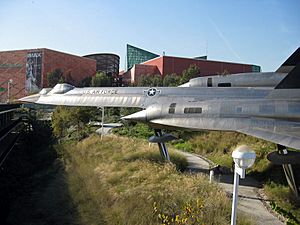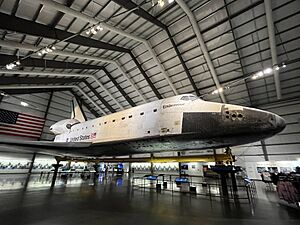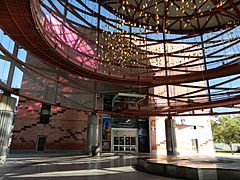California Science Center facts for kids
 |
|
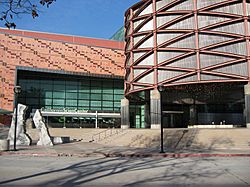 |
|
| Established | 1951 (as California Museum of Science and Industry) 1998 (as California Science Center) |
|---|---|
| Location | Exposition Park, Los Angeles, California, U.S. |
| Type | Science museum |
| Accreditation | AAM, ASTC, AZA |
| Visitors | 1,694,000 (2022) |
| Public transit access | |
The California Science Center is a super cool science museum in Exposition Park, Los Angeles. It's right next to the Natural History Museum of Los Angeles County and the University of Southern California. This museum is packed with amazing exhibits, including real aircraft and spacecraft like the Space Shuttle Endeavour.
You'll find lots of hands-on activities, special shows, and awesome IMAX movies. It's known as the biggest hands-on science center on the West Coast! The museum works together with the State of California and a special foundation. It started in 1951 as the "California Museum of Science and Industry" and was updated and renamed in 1998. Every year, it hosts the California State Science Fair.
History
How the Museum Started
The museum's story began way back in 1912. That's when the first California State Exhibition building opened in Exposition Park. This area used to be a fairground for farming from 1872 to 1910.
The original building showed off California's natural resources and products. This included things like farming, fishing, mining for coal and gold, oil, and lumber. After World War II, it also started featuring exhibits about science and technology.
Becoming a Science Museum
In 1951, the exhibition officially became the "California Museum of Science and Industry." The main building was named after a big supporter, Howard F. Ahmanson. The museum then added lots of hands-on exhibits.
These exhibits covered topics like farming, transportation, electricity, and different industries. In 1961, a new science area opened. It featured "Mathematica: A World of Numbers... and Beyond," an exhibit designed by Charles and Ray Eames. This exhibit helped people understand math concepts in a fun, visual way.
Big Changes in the 1980s
Before the 1984 Summer Olympics in Los Angeles, the museum added new exhibits. These included displays about earthquakes and how the economy works. A giant IMAX theater was also built.
The opening and closing ceremonies for the Olympics were held right next door at the Los Angeles Memorial Coliseum. The California African American Museum was also part of the science museum for a few years. It then moved to its own building nearby in 1984.
The Aerospace Museum
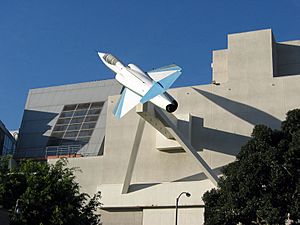
In 1984, the "California Aerospace Museum" opened next to the main science museum. It was designed by a famous architect, Frank Gehry. This museum focused on California's important role in aviation and space.
It had a huge, hangar-like space filled with aircraft and space artifacts. This building, now called the Air and Space Gallery, closed in 2011. Its future is still being decided.
Becoming the California Science Center
In 1988, the museum decided to make a big change. They planned to become a top science education center. This new place would be called the California Science Center. The old museum building closed in 1996 to get ready for construction.
The original main building was redesigned. Part of its old front still faces the Exposition Park Rose Garden. The rest of the old building was taken down. When the first part of the new center was finished, it officially opened in 1998 as the California Science Center.
Phase I: New Beginnings
The first part of the new California Science Center opened with exciting new areas:
- Science Plaza - Exhibits outside the main entrance, showing aircraft and science ideas.
- Exhibits inside - These included:
- World of Life - Exploring how living things work.
- Creative World - Showing how technology helps with transportation, communication, and buildings. It even had a virtual reality sports game and an earthquake simulator!
- Special Exhibits gallery - This room hosted temporary exhibits like ones about the Titanic or the human body.
- A brand new seven-story IMAX theater.
Phase II: Expanding Ecosystems
In 2010, the amazing Ecosystems exhibit opened. It lets visitors experience different natural environments. Other changes included:
- The historic Wallis Annenberg Building was renovated. It became a "Building for Science Learning and Innovation" in 2004. This building now includes learning centers and a public school focused on science.
- The SKETCH Foundation Gallery opened in 2002. It showed interactive exhibits and items on loan from NASA and The Smithsonian Institution.
- The Air and Space Gallery (the former California Aerospace Museum) closed in 2011. Its displays were moved into the main Science Center.
Phase III: Space Shuttle Home
A huge moment happened on April 12, 2011, when the California Science Center received the Space Shuttle Endeavour from NASA. It made an incredible journey through the streets of Los Angeles and arrived at the Science Center on October 14, 2012.
It was displayed in a temporary building called the "Samuel Oschin Pavilion" until December 31, 2023. This temporary home is now closed. The Space Shuttle is being prepared for its new permanent home, the Samuel Oschin Air and Space Center.
The Samuel Oschin Air and Space Center is a massive new addition to the Science Center. Construction started on June 1, 2022. The building itself is expected to be finished in mid-2025. After that, it will take several more years to install all the amazing artifacts and exhibits inside. An official grand opening date will be announced later.
This new building will have 150 new exhibits! It will include:
- Korean Air Aviation Gallery - About 20 real aircraft will be displayed, some on the floor and some hanging in the air. This includes a copy of the Wright Brothers’ 1902 Glider and a large part of a real Boeing 747 airliner.
- Kent Kresa Space Gallery - This section will show spacecraft from every part of the U.S. human space program. You'll see capsules like the Apollo-Soyuz Command Module and Gemini 11. There will also be models of probes that explored other planets and telescopes.
- Samuel Oschin Shuttle Gallery - This will be the home of the Space Shuttle Endeavour. It will be displayed standing up, as if ready for launch! It will have its huge external tank and two solid rocket boosters. You'll be able to see Endeavour from different levels, including a 200-foot-tall walkway for top-down views.
Permanent Exhibits
It's free to visit the California Science Center's main exhibit halls! You can also see various demonstrations and large aircraft and spacecraft for no charge. There are extra costs for special exhibits, movies in the IMAX theater, and fun activities like a climbing wall or a motion simulator.
Current Exhibits
World of Life
This exhibit explores how living things work, from tiny organisms to humans. It even has a giant titan arum flower on loan from the Huntington Library. You can also see BodyWorks, a 15-minute show with Tess, a 50-foot robot human body. Tess and her friend Walt explain how our bodies stay balanced.
Ecosystems
This huge, two-story exhibit lets you explore different natural environments. It has live animals and aquariums showing wildlife in places like rivers, deserts, polar regions, and the deep sea. There's even a massive 188,000-gallon kelp tank with over 1,500 live fish and other sea creatures. You can walk through an acrylic tunnel and feel like you're surrounded by the ocean!
Fire! Science & Safety
This exhibit is set up like an apartment building. It teaches you how important fire safety is. It also helps you learn what to do if a fire ever happens. This exhibit was created with the help of the Children's Burn Foundation.
Upcoming Exhibits
Samuel Oschin Air and Space Center
The Samuel Oschin Air and Space Center is the exciting new part of the California Science Center. This building will have three large galleries spread across four floors. It will cover over 100,000 square feet of exhibit space. This is where the Space Shuttle Endeavour will be displayed permanently, along with many other amazing aircraft and spacecraft.
Former Exhibits
Creative World
This exhibit used to explore how humans build things to meet their needs, like structures and transportation. It had an earthquake simulator that showed how the Science Center was built to be safe. There were also hands-on exhibits that showed how different building methods affect how strong a structure is.
Collection
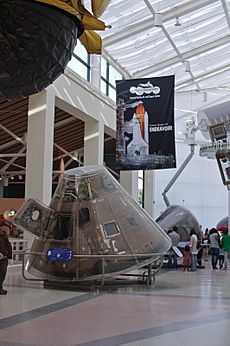
Spacecraft
- Mercury-Redstone 2 capsule: This capsule carried Ham, a chimpanzee, who was the first great ape in space (1961).
- Gemini 11 capsule: Flown by astronauts Pete Conrad and Richard F. Gordon Jr. in 1966.
- Apollo-Soyuz Test Project Command Module: From the 1975 mission where American and Soviet spacecraft linked up in space.
- SpaceX Dragon C108: This spacecraft went to orbit 3 times and spent almost 99 days in space.
- Rocket Lab Electron rocket: Used to launch satellites and was the first to use 3D printed engines.
- SKETCH Foundation Gallery: Has exhibits about the Solar System, space travel, and aviation. It displays historic aircraft, space vehicles, and equipment.
- Space Shuttle Endeavour: Being prepared for its new permanent home in the upcoming Samuel Oschin Air and Space Center. It will be displayed standing tall, with its external fuel tank and solid rocket boosters.
Aircraft
- Douglas DC-8 Jetliner
- Lockheed F-104D Starfighter
- Lockheed A-12 Oxcart: A two-seater trainer nicknamed "Titanium Goose."
- Replica Bell X-1: A movie prop from The Right Stuff.
- 1902 Wright Glider replica
- 1929 Velie Monocoupe
- Northrop T-38 Talon Jet Trainer
- Northrop F-20 Tigershark
- McDonnell Douglas F/A-18A Hornet
- Grumman F-11 Tiger
- Hawker Siddeley Harrier Jump Jet
Robotic Spacecraft
- Engineering prototype for Viking Lander
- Cassini-Huygens planetary probe (replica)
- Pioneer 10 planetary probe (replica)
- Mariner IV planetary probe (replica)
- Pioneer-Venus planetary probe (replica)
Attendance
In 2022, the California Science Center welcomed 1,694,000 visitors. This made it the 6th most-visited museum in the United States and the most-visited science museum in the U.S.!
Affiliations
The center is recognized by important groups like the American Alliance of Museums and the Association of Zoos and Aquariums. It's also part of the Association of Science and Technology Centers and the Smithsonian Affiliations program.
Gallery
See also
- List of most-visited museums in the United States
- List of works by Frank Gehry
- List of science centers
- List of aviation museums


